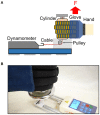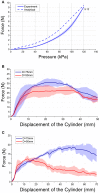Design and Preliminary Feasibility Study of a Soft Robotic Glove for Hand Function Assistance in Stroke Survivors
- PMID: 29062267
- PMCID: PMC5640819
- DOI: 10.3389/fnins.2017.00547
Design and Preliminary Feasibility Study of a Soft Robotic Glove for Hand Function Assistance in Stroke Survivors
Erratum in
-
Corrigendum: Design and Preliminary Feasibility Study of a Soft Robotic Glove for Hand Function Assistance in Stroke Survivors.Front Neurosci. 2018 May 8;12:323. doi: 10.3389/fnins.2018.00323. eCollection 2018. Front Neurosci. 2018. PMID: 29767142 Free PMC article.
Abstract
Various robotic exoskeletons have been proposed for hand function assistance during activities of daily living (ADL) of stroke survivors. However, traditional exoskeletons involve the use of complex rigid systems that impede the natural movement of joints, and thus reduce the wearability and cause discomfort to the user. The objective of this paper is to design and evaluate a soft robotic glove that is able to provide hand function assistance using fabric-reinforced soft pneumatic actuators. These actuators are made of silicone rubber which has an elastic modulus similar to human tissues. Thus, they are intrinsically soft and compliant. Upon air pressurization, they are able to support finger range of motion (ROM) and generate the desired actuation of the finger joints. In this work, the soft actuators were characterized in terms of their blocked tip force, normal and frictional grip force outputs. Combining the soft actuators and flexible textile materials, a soft robotic glove was developed for grasping assistance during ADL for stroke survivors. The glove was evaluated on five healthy participants for its assisted ROM and grip strength. Pilot test was performed in two stroke survivors to evaluate the efficacy of the glove in assisting functional grasping activities. Our results demonstrated that the actuators designed in this study could generate desired force output at a low air pressure. The glove had a high kinematic transparency and did not affect the active ROM of the finger joints when it was being worn by the participants. With the assistance of the glove, the participants were able to perform grasping actions with sufficient assisted ROM and grip strength, without any voluntary effort. Additionally, pilot test on stroke survivors demonstrated that the patient's grasping performance improved with the presence and assistance of the glove. Patient feedback questionnaires also showed high level of patient satisfaction and comfort. In conclusion, this paper has demonstrated the possibility of using soft wearable exoskeletons that are more wearable, lightweight, and suitable to be used on a daily basis for hand function assistance of stroke survivors during activities of daily living.
Keywords: activities of daily living; hand exoskeleton; rehabilitation; soft actuators; soft robotic.
Figures









Similar articles
-
Characterisation and evaluation of soft elastomeric actuators for hand assistive and rehabilitation applications.J Med Eng Technol. 2016;40(4):199-209. doi: 10.3109/03091902.2016.1161853. Epub 2016 Mar 23. J Med Eng Technol. 2016. PMID: 27007297
-
Design and characterization of low-cost fabric-based flat pneumatic actuators for soft assistive glove application.IEEE Int Conf Rehabil Robot. 2017 Jul;2017:1465-1470. doi: 10.1109/ICORR.2017.8009454. IEEE Int Conf Rehabil Robot. 2017. PMID: 28814026
-
Development and feasibility of a soft pneumatic-robotic glove to assist impaired hand function in quadriplegia patients: A pilot study.J Bodyw Mov Ther. 2021 Jul;27:731-736. doi: 10.1016/j.jbmt.2021.03.012. Epub 2021 Apr 2. J Bodyw Mov Ther. 2021. PMID: 34391314
-
Moving toward Soft Robotics: A Decade Review of the Design of Hand Exoskeletons.Biomimetics (Basel). 2018 Jul 18;3(3):17. doi: 10.3390/biomimetics3030017. Biomimetics (Basel). 2018. PMID: 31105239 Free PMC article. Review.
-
Soft robotic devices for hand rehabilitation and assistance: a narrative review.J Neuroeng Rehabil. 2018 Feb 17;15(1):9. doi: 10.1186/s12984-018-0350-6. J Neuroeng Rehabil. 2018. PMID: 29454392 Free PMC article. Review.
Cited by
-
Assisting hand function after spinal cord injury with a fabric-based soft robotic glove.J Neuroeng Rehabil. 2018 Jun 28;15(1):59. doi: 10.1186/s12984-018-0391-x. J Neuroeng Rehabil. 2018. PMID: 29954401 Free PMC article. Clinical Trial.
-
Development of a novel hybrid securing actuator for a self-securing soft robotic hand exoskeleton.Front Robot AI. 2023 Jul 25;10:1164819. doi: 10.3389/frobt.2023.1164819. eCollection 2023. Front Robot AI. 2023. PMID: 37559571 Free PMC article.
-
Intention Detection Strategies for Robotic Upper-Limb Orthoses: A Scoping Review Considering Usability, Daily Life Application, and User Evaluation.Front Neurorobot. 2022 Feb 21;16:815693. doi: 10.3389/fnbot.2022.815693. eCollection 2022. Front Neurorobot. 2022. PMID: 35264940 Free PMC article.
-
Therapy effect on hand function after home use of a wearable assistive soft-robotic glove supporting grip strength.PLoS One. 2024 Jul 11;19(7):e0306713. doi: 10.1371/journal.pone.0306713. eCollection 2024. PLoS One. 2024. PMID: 38990858 Free PMC article. Clinical Trial.
-
Personalized robots for long-term telerehabilitation after stroke: a perspective on technological readiness and clinical translation.Front Rehabil Sci. 2024 Jan 8;4:1329927. doi: 10.3389/fresc.2023.1329927. eCollection 2023. Front Rehabil Sci. 2024. PMID: 38259875 Free PMC article.
References
-
- Agarwal P., Fox J., Yun Y., O'malley M. K., Deshpande A. D. (2015). An index finger exoskeleton with series elastic actuation for rehabilitation: design, control and performance characterization. Int. J. Rob. Res. 34, 1747–1772. 10.1177/0278364915598388 - DOI
Publication types
LinkOut - more resources
Full Text Sources
Other Literature Sources
Medical

